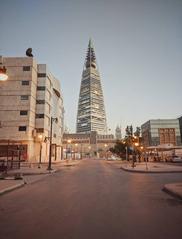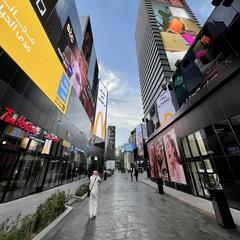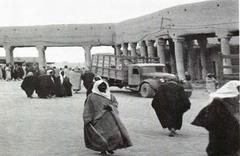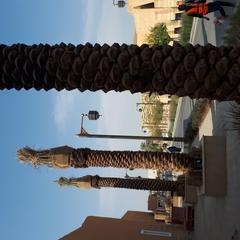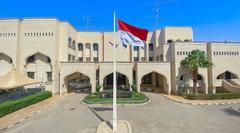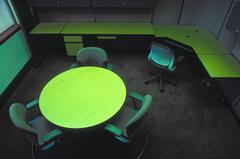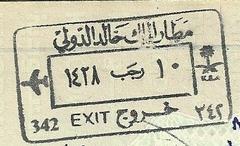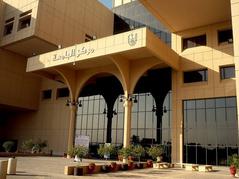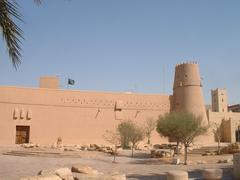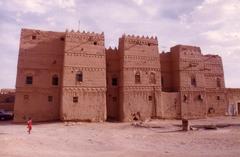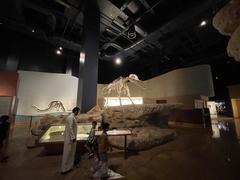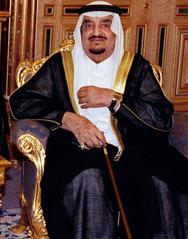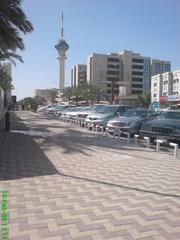Imam Turki Bin Abdullah Mosque Riyadh: Visiting Hours, Tickets, and Historical Significance
Date: 14/06/2025
Introduction
Imam Turki Bin Abdullah Mosque, often called the Grand Mosque of Riyadh, stands as a monumental symbol of Saudi Arabia’s spiritual, cultural, and architectural heritage. Located in the historic center of Riyadh, this mosque is named after Imam Turki bin Abdullah, the founder of the Second Saudi State, and is deeply intertwined with the city’s evolution from a traditional settlement to a thriving modern capital. With origins in the 19th century and a comprehensive reconstruction culminating in 1993, the mosque today not only serves as a major religious center accommodating up to 17,000 worshippers but also functions as a hub for Islamic learning and community gatherings, especially during Ramadan and Eid (Funadiq, Trip.com).
Architecturally, the mosque harmonizes traditional Najdi design with contemporary features, employing local brown Riyadh limestone, white marble, and intricate Islamic geometric patterns. Its two 50-meter minarets, grand central dome, and thoughtfully zoned interiors—including gender-specific prayer halls and libraries—reflect both reverence for heritage and commitment to accessibility. The mosque is open daily, with extended hours during religious festivals. Entry is free, but visitors are expected to observe modest dress and respectful conduct. Its proximity to icons like Al Masmak Fortress, Deera Square, and the National Museum makes it an essential stop for those exploring Riyadh’s storied past (Visit Saudi).
This guide provides a detailed overview of the mosque’s history, architecture, cultural role, and practical visitor information—including visiting hours, ticketing, etiquette, accessibility, and travel tips—ensuring you have a meaningful experience at one of Riyadh’s most cherished historical sites.
Table of Contents
- Historical Evolution
- Architectural Features
- Religious and Cultural Significance
- Practical Visitor Information
- Visitor Etiquette and Tips
- Nearby Attractions
- Frequently Asked Questions (FAQ)
- Conclusion
- References and Further Reading
Historical Evolution
Origins and Early Importance
Founded in the 19th century near Al Masmak Fortress, the Imam Turki Bin Abdullah Mosque was initially a center for worship and community gatherings during Riyadh’s formative period. Its strategic placement and role as a congregational mosque contributed to the consolidation of Saudi authority and the spread of Islamic culture in the region (Funadiq).
Reconstruction and Modernization
With Riyadh’s rapid growth, the mosque was extensively reconstructed and modernized, reopening in 1993 with the capacity to welcome 17,000 worshippers. The renovation, led by architect Rasem Badran, preserved Najdi architectural themes while incorporating advanced amenities and accessibility features, cementing the mosque’s status as a key venue for religious and national events (Springer).
Architectural Features
Design Philosophy and Najdi Influence
The mosque’s architecture is a refined blend of traditional Najdi style—emphasizing geometric simplicity, thick stone walls, and climate-adaptive features—and contemporary construction methods. The use of local limestone and marble results in a visually striking structure, especially when illuminated at night (Funadiq).
Minarets and Dome
Two 50-meter minarets, adorned with intricate motifs and calligraphy, rise above the mosque, serving both spiritual and architectural purposes. The grand central dome, allowing natural light to flood the prayer hall, creates a tranquil worship space and symbolizes unity (Mosqpedia).
Interior Layout
The mosque covers 16,800 square meters. There are spacious prayer halls for men and women, each with dedicated libraries, ablution areas, and educational facilities. Marble floors and detailed wall decorations contribute to an atmosphere of reverence and serenity.
Courtyards and Ancillary Spaces
A large courtyard provides overflow space during peak prayer times and religious festivals, while landscaped areas encourage social interaction and contemplation.
Accessibility and Modern Technology
The mosque is fully accessible, with ramps and wide entrances. It is equipped with advanced sound and broadcasting systems, enabling live transmission of prayers and sermons (Springer).
Architectural Recognition
In 1995, the mosque received the Aga Khan Award for Architecture, recognizing its exemplary integration of tradition and innovation.
Religious and Cultural Significance
Central Role in Riyadh’s Islamic Life
Imam Turki Bin Abdullah Mosque is a focal point for communal prayers, especially during Ramadan, Eid al-Fitr, and Eid al-Adha. It regularly hosts Quran recitation circles, lectures, and educational seminars, nurturing Islamic scholarship and spiritual growth (Trip.com).
Cultural Heritage and Social Identity
The mosque embodies the identity of Riyadh, situated near the historic Qasr Al-Hukm District and seamlessly connected to political and social landmarks. Its design and function reflect Saudi society’s reverence for tradition alongside progress (Visit Saudi).
Venue for Events and Community Life
During religious festivals, the mosque’s plazas become vibrant centers for gatherings and celebrations. The mosque also supports charitable initiatives and social outreach programs.
Practical Visitor Information
Location
The mosque is in Riyadh’s historic ad-Dirah neighborhood, adjacent to Al Masmak Fortress and Deera Square. It is easily reachable by car, taxi, or public transport (Holidify).
Visiting Hours
- General Hours: 8:00 AM – 9:00 PM daily
- During Ramadan and Religious Occasions: Extended hours (check locally for updates)
- Prayer Times: Visitors not participating in prayers should avoid entering prayer halls during these periods.
Entry and Tickets
- Entry Fee: Free
- Ticketing: No tickets required; entry is restricted to Muslims only, as per Saudi mosque policy (TravellingFoot)
Guided Tours
While official guided tours within the mosque are limited, local guides in the historic district may offer context about the mosque and nearby sites. Inquire at tourism offices for the latest offerings.
Accessibility
The mosque is fully accessible, with ramps, wide doorways, and accessible ablution areas.
Visitor Etiquette and Tips
- Dress Code:
- Women: Modest clothing covering shoulders to ankles and a headscarf (abayas are available locally).
- Men: Long trousers and shirts with sleeves; shorts and sleeveless tops are prohibited.
- Shoes: Remove before entering prayer halls; racks are provided.
- Behavior: Maintain quiet, silence phones, and avoid photography inside unless permitted.
- Gender Separation: Follow signage for separate entrances and prayer areas.
- Respect Prayer Times: Tourists should avoid entering prayer halls during prayers to prevent disruption (Travelermania).
Nearby Attractions
- Al Masmak Fortress: Key historical site adjacent to the mosque.
- Deera Square: Historic public square, formerly used for judicial events.
- National Museum of Saudi Arabia: Offers deep insights into the country’s heritage.
- Deira Souq and Governor’s Palace: Traditional markets and political landmarks within walking distance (Holidify).
Frequently Asked Questions (FAQ)
Q: What are the visiting hours?
A: 8:00 AM to 9:00 PM daily, with extended hours during Ramadan and major religious occasions.
Q: Is there an entry fee?
A: Entry is free; no tickets required.
Q: Can non-Muslims visit the mosque?
A: Entry is restricted to Muslims only, but non-Muslims can explore the surrounding historic district.
Q: Are guided tours available?
A: Limited; inquire with local tourism offices for updates.
Q: What should I wear?
A: Modest attire is required; women must cover their heads, arms, and legs.
Q: Is the mosque accessible for people with disabilities?
A: Yes, there are ramps and accessible facilities.
Conclusion
Imam Turki Bin Abdullah Mosque stands as a living testament to Riyadh’s spiritual, cultural, and architectural legacy. Its harmonious blend of Najdi tradition and modern functionality, strategic location among historic sites, and ongoing role as a center for worship, learning, and community life make it a must-visit destination. By observing proper etiquette and making use of the mosque’s facilities and its proximity to other attractions, visitors can enjoy a rich, respectful, and memorable experience in the heart of Riyadh.
For updated information, guided tours, and further tips, download the Audiala app and consult official tourism resources. Embrace this opportunity to connect with Saudi Arabia’s vibrant heritage and witness firsthand the convergence of faith, history, and architecture.
References and Further Reading
- Funadiq – 7 Most Magnificent Mosques In Riyadh With Religious Significance
- Trip.com – Imam Turki Bin Abdullah Grand Mosque Visitor Guide
- Springer – Najdi Architecture and Modern Recognition
- Holidify – Visiting the Imam Turki Bin Abdullah Mosque
- Wikipedia – Imam Turki Bin Abdullah Grand Mosque
- Visit Saudi – Imam Turki Bin Abdullah Mosque
- Mosqpedia – Great Mosque of Riyadh
- TravellingFoot – Imam Turki Bin Abdullah Grand Mosque
- Travelermania – Riyadh Etiquette Tips
- MakeMyTrip – Imam Turki Bin Abdullah Mosque Attraction
